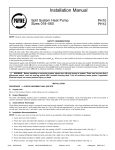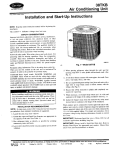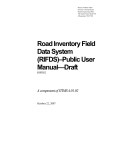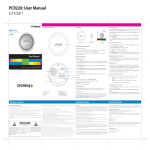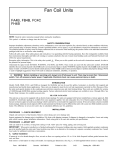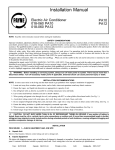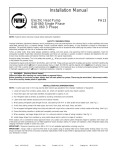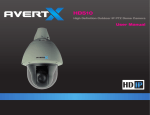Download Installation Manual
Transcript
Installation Manual PH10 PH12 Split System Heat Pump Sizes 018-060 NOTE: Read the entire instruction manual before starting the installation. SAFETY CONSIDERATIONS improper installation, adjustment, alteration, service, maintenance, or use can cause explosion, fire, electrical shock or other conditions which may cause personal injury or property damage. Consult a qualified installer, service agency or your distributor or branch for information or assistance. The qualified installer or agency must use factory-authorized kits or accessories when modifying this product. Refer to the individual instructions packaged with the kits or accessories when installing. Follow all safety codes. Wear safety glasses and work gloves. Use quenching cloth for brazing operations. Have fire extinguisher available. Read these instructions thoroughly and follow all warnings or cautions attached to the unit. Consult local building codes and the National Electrical Code (NEC) for special installation requirements. Recognize safety information. This is the safety-alert symbol Z_x • When you see this symbol on the unit or in instructions and manuals, be alert to the potential for personal injury. Understand the signal words DANGER, WARNING, and CAUTION. These words are used with the safety-alert symbol. DANGER identifies the most serious hazards which will result in severe personal injury or death. WARNING signifies hazards which could result in personal injury or death. CAUTION is used to identify unsafe practices which would result in minor personal injury or product and property damage. NOTE is used to highlight suggestions which wiUresult in enhanced installation, reliability, or operation. _x WARNING: Before installing or servicing system, always turn off main power to system. There may be more than 1 disconnect switch. Lock out and tag switch with a suitable warning label. Turn off accessory heater power if applicable. Electrical shock can cause personal injury or death INSTALLATION PROCEDURE A. Unpack Move B. to final Inspect I--CHECK EQUIPMENT AND JOB SITE Unit location. Remove carton taking care not to damage unit. Equipment File claim with shipping company, prior to installation, if shipment is damaged or incomplete. Locate unit rating plate contains information needed to properly install unit. Check rating plate to be sure unit matches job specifications. C. Check Defrost D. Note that only Installation NOTE: noise in living from 2. Ensure that vapor and liquid tube diameters 4. Leave some 5. When passing 6. Avoid direct header, and on most units it is the bottom circuit. tubes as directly refrigerant tubing necessary, as possible structure tubes contact refrigerant that tubing to gas pulsations from improper installation of equipment. windows. slack between 7. Do not suspend IM-PH10-06 with liquid area has been traced unit away 3. Run refrigerant Form: 1 stub tube is used Recommendations In some cases 9. When It located and securely attached. A liquid header with a brass distributor and feeder tube goes into there is a 3/8-in. OD stub tube approximately 3 in. long. The defrost thermostat should be located I. Locate 8. Ensure panel. Thermostat Check defrost thermostat to ensure it is properly outdoor coil. At the end of i of the feeder tubes, on stub tube. on unit service are appropriate by avoiding and unit to absorb through wall, to capacity unnecessary of unit. (See Table I.) turns and bends. vibration. seal opening with RTV ductwork, tubing from joists and studs with a rigid wire or strap which comes use hanger Cancels: is pliable straps and it completely which are I-in. wide IM-PH10-O5/IM-PH12q)1 surrounds wall studs, silicon-based water pipes, insulation floor joists, or other pliable with vapor and conform floors, caulk. (See Fig. 1.) and walls. in direct contact with tubing. (See Fig. 1.) tube. to shape of tubing Printed in U.S.A. insulation. 11-01 (See Fig. I.) Catalog No. 53PH-1017 NOTE: AVOID CONTACT BETWEEN TUBING AND STRUCTURE HANGER STRAP (AROUNDVAPOR JOIST L,NE ONLy) () LINE ) VAPOR ,NSOLAT,ON iNSULATION THROUGH THE WALL % susPENS,O. VAPOR LINE LIQL A01443 Fig. l--Piping Table 1--Refrigerant Connections and Recommended Liquid and Vapor Tube Diameters (In.) LIQUID VAPOR Connect Diameter Tube Diameter Connect Diameter Tube Diameter 3/8 3/8 5/8 5/8 3/8 3/8 3/4 3/4 3/8 3/8 7/8 7/8 3/8 3/8 7/8 1-1/8 UNIT SIZE PH10 PH12 018, 024 018 030, 036 024-036 042,048 060 042,048 060 NOTE: Tube diameters 10. Isolate hanger PROCEDURE Installation are for lengths up to 50 ft. For tubing lengths greater than 50 ft, consult your local distributor. straps from insulation 2--INSTALL by using metal sleeves bent to conform ON A SOLID, LEVEL MOUNTING to shape of insulation. PAD if conditions or local codes require unit be attached to pad, tie-down bolts should he used and fastened through knockouts provided in unit base pan. Refer to unit mounting pattern in Fig. 2 to determine base pan size and knockout hole location. For minimum pad dimensions see Fig. 2. When installing, allow sufficient space for airflow clearance, wiring, refrigerant piping, and service. Allow 30-in. clearance to service end of unit and 48 in. above unit. For proper airflow, a 6-in. clearance on I side of unit and 12 in. on all remaining sides must be maintained. Maintain a distance of 24 in. between units. Discharge air must be unobstructed and must not recirculate. Position so water, snow or ice from roof or eaves cannot fall directly on unit. On rooftop applications, locate unit at least 6 in. above roof surface. Place unit above a load-bearing wall and isolate unit and tubing set from structure. Arrange supporting members to adequately support unit and minimize transmission of vibration to building. Consult local codes governing rooftop applications. The minimum outdoor operating ambient in cooling mode is 55°F (12.8°C), and the maximum outdoor operating ambient in cooling mode is 125°F (51.6°C). The maximum outdoor operating ambient in heating mode is 66F (18.8°C). PROCEDURE Z_ 3--ELEVATE CAUTION: UNIT Accumulation of water and ice in base pan may cause equipment damage. in areas where prolonged freezing temperatures are encountered, estimated anowtZan level and ensure adequate drainage of unit. PROCEDURE 4iREPLACE CHECK*FLO*RATER® elevate PISTON unit per local climate (IF REQUIRED) and code requirements OR TXV (REQUIRED to provide clearance above ON PH12) if unit is being installed with piston, check indoor coil piston to see if it matches required piston shown on Emit rating plate. If it does not match, replace indoor coil piston with piston shipped with outdoor unit. The indoor piston shipped with outdoor unit is correct for any approved indoor coil combination. NOTE: ifa TXV is to be installed CAUTION: Check outdoor unit piston 2. Remove outdoor After verifying holding outdoor piston and check coil piston. size, reinstall piston piston in liquid size with matching and retainer. service number If O-ring valve. on unit rating is damaged during plate. removal, install new retainer. Models: removing existing For TXV kit part number hard shutoff indoor as follows: cap and retainer 3. After unit, remove Do not install with evaporator coils having capillary tube metering devices. I. Remove ---->For PH12 on indoor Check-FIe-Ruter and charging TXV, no TXV change from indoor instructions, coil, install field-supplied bi-flow hard shutoff refer to TXV label on your unit. If indoor is required. .... 2__. TXV kit. unit (fan coil) comes factory equipped with a hi-flow AIR IN 3/8" DIA, TIEDOWN KNOCKOUTS A A01340 A B c D PH10 018-030; PH12 018 22-1/2 18-1/2 8-3/16 4-1/16 PH10 036-060; PH12 024-060 30 23-1_ 10 6-1/2 UNIT SIZE Fig. 2--Unit Dimensions in Inches install TXV kit to indoor coil as follows: 1. Install suction tube adapter. 2. Install liquid flare-to-sweat adapter, 3. Connect external equalizer tube to fitting on suction tube adapter. 4. Position sensing bulb on horizontal portion of suction tube adapter. Secure using supplied hardware. 5. Insulate bulb after installation. 6. Leak check all connections. PROCEDURE injury 5iMAKE PIPING CONNECTIONS CAUTION: Relieve pressure and recover all refrigerant before system repair or final unit disposal to avoid personal or death. Use all service ports and open all flow-control devices, including solenoid valves. CAUTION: If any refrigerant tubing is buried, provide a minimum 6-in. vertical rise to valve connections at unit. Refrigerant tubing lengths up to 36 in. may be buried without further consideration. For buried lines longer than 3 ft, consult your local distributor. Outdoor condition. distributor. units may be connected if refrigerant contamination A. to indoor sections using accessory tubing package For tubing requirements beyond 50 It, consult Residential Split-System Refer to Table I for refrigerant tube dimensions and connections. tubes or indoor coil is exposed and moisture in system Outdoor Units Connected to atmospheric to Factory-Approved conditions for longer or field-supplied Long-Line Application than 5 minutes, refrigerant grade Guideline it must be evacuated Refrigerant Connect C. tubing of correct is available to 500 microns size and at your local to eliminate Indoor Outdoor unit contains correct system refrigerant charge for operation with indoor unit of same size when connected factory accessory tubing. Check refrigerant charge for maximum efficiency. (See Procedure 9-Check Charge.) B. tubing which by 15 fl of field-supplied or Tubing to fittings on outdoor unit vapor and liquid service valves. Sweat Connection CAUTION: To prevent damage to unit or service valves while brazing, use a brazing shield, and wrap service valves with wet cloth or use a heat sink material Use refrigerant grade tubing. Service valves are closed from factory and ready for brazing. Remove plastic retainer holding outdoor piston in liquid service valve and connect sweat/flare adapter provided to valve, (See Fig. 3.) After wrapping the service valve with a wet cloth, braze sweat connections using industry accepted methods and materials. Consult local code requirements. Refrigerant tubing and indoor coil are now ready for leak testing. This check should include all field and factory joints. .... 3___ PISTON PISTON PISTON RETAINER STRAINER SWEAWFLARE ADAPTER A97512 PROCEDURE 6iMAKE _x WARNING: removed. ELECTRICAL Fig. 3iService Valve with Sweat Adapter Tube CONNECTIONS To avoid personal injury or death, do not supply power to unit with compressor terminal box cover Be sure field wiring complies with local and national fire, safety, and electrical codes, and voltage to system is within limits shown on unit rating plate. Contact local power company for correction of improper voltage. See unit rating plate for recommended circuit protection device. NOTE: Operation of unit on improper line voltage constitutes abuse and could affect unit reliability. See unit rating plate. Do not install unit in system where voltage or phase imbalance (3 phase) may fluctuate above or below permissible limits. NOTE: Use copper wire only between disconnect switch and unit. NOTE: install branch circuit disconnect per NEC of adequate size to handle unit starting current. Locate disconnect within sight from and readily accessible from unit, per Section 440-14 of NEC. A. Route Ground and Power Wires Remove access panel to gain access to unit wiring. Extend wires from disconnect through power wiring hole provided and into unit control box. _x WARNING: The cabinet must have an uninterrupted or unbroken ground to minimize personal injury if an electrical fault should occur. The ground may consist of electrical wire or metal conduit when installed in accordance with existing electrical codes. Failure to follow this warning could result in an electrical shock, fire, or death. B. Connect Ground and Power Wires Connect ground wire to ground connection in control box for safety. Connect power wiring to contactor as shown in Fig. 4. C. Connect Control Wiring Route 24v control wires through control wiring grommet and connect leads to control wiring. (See Fig. 6 and 7.) Use No. 18 AWG color-coded, insulated (95°F/35°C minimum) wires. If themlostat is located more than 100 ft from unit (as measured along control voltage wires), use No. 16 AWG color*coded wires to avoid excessive voltage drop. Use furnace- or tan-coil transformer as 24v (40va minimum) supply for system or use accessory transformer. NOTE: Use of available 24v accessories may exceed the minimum 40va power requirement. Determine total transformer loading and increase the transformer capacity or split the load with an accessory transformer as required. NOTE: The defrost timer is factory set for 90*minute cycles. The timer can be field set for 30- and 50-minute cycles depending on defrost conditions in your geographical location. PROCEDURE 7--INSTALL ELECTRICAL ACCESSORIES Refer to individual instructions packaged with kits or accessories PROCEDURE when installing. 8--START-UP _x CAUTION: To prevent compressor damage or personal injury, DO NOT over charge system with refrigerant, operate unit in a vacuum or at negative pressure, or disable low pressure switch. Dome temperatures may be HOT in scroll compressor units! .m. 4 ........ DISCONNECT PER N.E.C. AN_OR LOCALCODES CONTACTOR FIELD POWER WIRING BLUE 3 PHASE ONLY FIELD GROUND WIRING GROUND LUG A94025 Fig. 4--Line 1. If equipped with a crankcase heater, energize a minimum and close electrical disconnect to outdoor unit. A crankcase heater and liquid-line solenoid are required Power Connections of 24 hr before if refrigerant tubing starting is longer unit. To energize heater only, set thermostat to OFF mode than 50 ft. CAUTION: To prevent personal injury wear safety glasses, protective clothing, and gloves when handling refrigerant. Front seating service valves are equipped with Schrader valves. 2. Fully open liquid and vapor service valves. 3. Unit is shipped with valve stem(s) front seated, and caps installed. Replace stem caps after system is opened to refrigerant flow. Replace caps finger-tight and tighten additional I/6 turn with wrench for front seating valves (female hex stem). 4. Close electrical disconnects to energize system. 5. Set room thermostat at desired temperature. 6. Set room thermostat at HEAT or COOL and fan to ON or AUTO mode, as desired. Operate unit for 15 minutes. Check system refi-igerant charge. (See Procedure 9.) 7. Factory charge is shown on outdoor rating plate. Adjust charge in cooling mode by following procedure shown on charging table. Check charge in heating mode by following procedure shown on heating check charge. Both are located on outdoor unit CAUTION: Do not vent refrigerant into atmosphere. Relieve pressure and recover all refrigerant before system repair or final unit disposal to avoid personal injury or death. Use all service ports and open all flow-control devices, including solenoid valve CAUTION: • 3-phase scroll compressors are rotation sensitive. • A flashing LED on phase monitor indicates reverse rotation. (See Fig. 5 and Table 2.) • This will not allow contactor to be energized. • Disconnect power to unit and interchange 2 field wiring leads on unit contactor. A. With SEQUENCE power OF OPERATION supplied to indoor and outdoor units, transformer is energized. COOLING On a call for cooling, thermostat makes circuits R-O, R-Y, and R_G. Circuit R-O energizes reversing valve, switching it to cooling position. On three phase models with scroll compressors, the units are equipped with a phase monitor to detect if the incoming power is correctly phased for compressor operation. (See Fig. 18 and Table 3.) if the phasing is correct, circuit R-Y energizes contactor, starting outdoor fan motor and compressor circuit. R-G energizes indoor unit blower relay, starting indoor blower motor on high speed. NOTE: If the phasing is incorrect, the contactor will not be energized. To correct the phasing interchange any two of the three power connections on the field side. When thermostat NOTE: is satisfied, contacts open, de-energizing the contactor aart blower relay. Compressor and motors should stop. If indoor unit is equipped with a time-delay relay circuit, the blower runs an additional 90 sec to increase system efficiency. HEATING On a call for heating, thermostat makes circuits R-Y and R-G. If phasing is correct, circuit R-Y energizes contactor, starting outdoor tZanmotor and compressor. Circuit R-G energizes indoor blower relay, starting blower motor on high speed. Should temperature continue to fall, R-W2 is made through secood-stage room thermostat. Circuit R-W2 energizes a relay, bringing on first bank of supplemental electric heat. If outdoor temperature falls below setting of outdoor thermostat (fieldqnstaned option), contacts close to complete circuit and bring on second bank of supplemental electric heat. ..... 5 .... CDNTACTDR 24VAC COM OFF:NO ON:OK FLASH:PHASE O 24WAC PROBLEM 0 L3 L1 A00010 Fig. 5iphase Table 2--Phase Monitor Control Monitor LED Indicators LED STATUS OFF No call for compressor FLASHING ON When thermostat operation Reversed phase Normal is satisfied, its contacts open, de*energizing contactor and relay. All heaters and motors should stop. DEFROST The defrost control is a time/temperature control which includes a field-selectable defrost cycles (30, 50, and 90 minutes), factory set at 90 minutes. The electronic timer and defrost cycle will start only when centacter (quick-connects located at board edge) time period between is energized and defrost thermostat is closed. The defrost mode is identical to cooling mode except that outdoor fan motor stops and a second*stage heat is turned on to continue warming conditioned space. PROCEDURE 9iCHECK CHARGE Factory charge is shown on unit rating plate. CAUTION: Compressor damage may occur if system is overcharged. Adjust charge in cooling mode by following procedure shown on superheat charging tables. Check charge in heating mode by following procedure shown on heating check chart, both located on unit. CAUTION: PROCEDURE Do not vent refrigerant to atmosphere. 10iCARE Recover during system repair or final unit disposal. AND MAINTENANCE For continuing high performance, and to minimize possible equipment failure, it is essential that periodic maintenance be performed on this equipment. Consult your servicing contractor or Users Manual for proper frequency of maintenance. Frequency of maintenance may vary depending upon geographic areas, such as coastal applications. PROCEDURE 11iLEAVE USER'S MANUAL WITH HOMEOWNER Explain system operation and maintenance procedures outlined in User's Manual. .... 6__. FAN COIL (CONTROL) THERMOSTAT HEAT PUMP CONTROL _R c WHT Z_ c W2 [] _w2 A94060 Fig. 6---Wiring Layout PFMNA018 through A070 Thermostat Subbase Indoor Outdoor Terminal Block Terminal Boa_ IW_l Z_L % Fq % [_ % Fq [_ A93102 Fig. 7--Wiring Layout PFIMNA071 .... 7 .... © 2001 Payne Heating & Cooling 7310 W. Morris St., indianapolis, IN 46231 ----8--- imphl006 Catalog No, 53PH-1017








